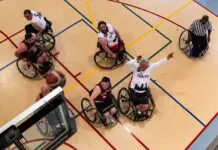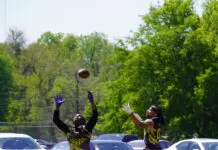Being a hockey player in Oklahoma is no easy task. Like any sport, it takes time, dedication and skill to make the cut with competitive groups around the state. Oklahoma has an array of hockey teams in different leagues and tiers, although several have come and gone throughout the years. Two prominent teams are the Tulsa Oilers – part of the East Coast Hockey League (ECHL) – and the Oklahoma City Ice Hawks – part of the North American 3 Hockey League (NA3HL).
“The ECHL is the ‘AA’ level of professional hockey in North America,” says Zack Reynolds, broadcaster and director of media relations for the Oilers.
The NA3HL, on the other hand, is a tier III junior hockey league consisting of 16 states, with players between the ages of 16 and 21.
“Several of [the Oilers] players are assigned directly from the Anaheim Ducks and the San Diego Gulls,” says Reynolds, with the rest coming from new and returning players of the NCAA or the Canadian Major Junior ranks. “Major Junior is the most common path of players to the [National Hockey League], but the NCAA is quickly carving a large portion of the NHL out.”
A regular season for the Oilers is 72 games, which is only ten less than the NHL. The NA3HL, a junior league, only plays 47 games.
“[Oilers] players are usually on the ice five to six times a week, with the occasional full seven day week,” says Reynolds.
Generally, the Oilers average three to four games weekly, usually played from Friday to Sunday. If they aren’t playing a game, they’re almost certainly at practice running drills.
“Practices run about an hour and fifteen minutes, but most guys hang on the ice afterward to work on individual skills,” says Reynolds.
The Tulsa Oilers play their home games at the BOK Center in downtown Tulsa. The OKC Ice Hawks home games are played at Arctic Edge Ice Arena in Edmond.
In the off-season, activities and career choices vary from player to player.
“A majority of players return to their hometowns to work skills individually,” says Reynolds. Many may also take up internships or externships as a backup plan to “set them up with some experience if they don’t make it to the NHL.”
Of course, to stay on the up and up, players have to do plenty of strength training during and outside of the season.
“Athletes do a lot of maintenance work to keep their joints in shape during the year,” says Reynolds. Weight lifting is chief among them. “Guys will do weight lifting individually throughout the season, both at the rink and at a series of gyms we have a deal with here in the area.”
Know the Slang
Barnburner – A high-scoring game
Biscuit – Another name for the puck
Chirp – Trash talking the opposing team
Duster – A benchwarmer, or someone collecting dust on the bench from lack of playtime
Flamingo – Lifting a leg to get out of the way of a shot
Light the Lamp – Scoring a goal (the red light goes off when a score is made)
Sin Bin – The penalty box

























